| |
|
Washington Crossing |
New Jersey |
USA |
Horizontal Dial |
Dial 164 |
| A 13-inch diameter horizontal dial made of iron. The dial has hour lines from 5am to 7pm, marked with Roman numerals. The gnomon is of unusual design. Set at 45 degrees, the style is supported by the profile of an eagle, head facing northward, and tail tapering to the southern point of the style. The base is a square pedestal, cobbled of stone and mortar. At top is a stone cut square to hold the dial. |
| |
| |
|
New Bedford |
Massachusetts |
USA |
Vertical Dial |
Dial 163 |
| 1820 Federal style building owned by the Univ. of Mass. at Dartmouth. Referred to as the Sundial building because of a vertical dial over the main entrance. |
| |
| |
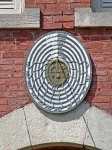 |
Burlington |
Vermont |
USA |
Vertical Dial |
Dial 161 |
| 2'8" x 2' oval. Probably of Bronze. Gift of Mr. & Mrs. Willard Pope. Planned by Prof. Betty Bandel. Hour lines are curved to compensate for EoT. Rings indicate months. Difficult to read due to height above ground. (ca. 12' above ground level.) Dial faces approx 5 degrees East of due South. Built by W. M. Schenk. |
| |
| |
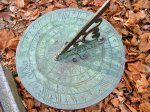 |
Philadelphia |
Pennsylvania |
USA |
Horizontal Dial |
Dial 160 |
| A 1 foot diameter bronze horizontal dial. It was presented by National Association of Watch and Clock Collectors in 1991. However, the style angle is 52deg |
| |
| |
|
Laramie |
Wyoming |
USA |
Horizontal Dial |
Dial 159 |
| An ornate 18 inch brass horizontal dial sits on a massive four-stone block pedestal. The dial has hour lines from 4am to 8pm, with hours in roman numerals. Time is graduated into 5-minute intervals. The 12-noon mark is 3/8 inch wide, allowing for the gnomon which is missing. |
| |
| |
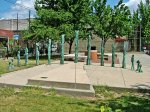 |
Philadelphia |
Pennsylvania |
USA |
Analemmatic Dial |
Dial 158 |
| Analemmatic dial with bronze standing figures. |
| |
| |
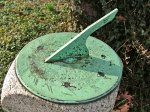 |
Philadelphia |
Pennsylvania |
USA |
Horizontal Dial |
Dial 157 |
| A 1 foot diameter bronze horizontal dial on a square granite pedestal 3 feet tall. Possibly made in 18th century. Beautiful engraving. |
| |
| |
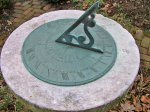 |
Philadelphia |
Pennsylvania |
USA |
Horizontal Dial |
Dial 156 |
| A 1 foot diameter bronze horizontal dial in backyard garden. May be from 18th century. The gnomon is shaky for its bolts are loose. Style angle is about 51deg, an angle for London, not for Philadelphia. |
| |
| |
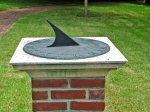 |
Philadelphia |
Pennsylvania |
USA |
Horizontal Dial |
Dial 150 |
| A 21 inch diameter horizontal dial on three foot brick pedestal. Hour lines only. Gnomon reclined. Made in 1989 to commemorate Bicentennial of the General Assembly Presbyterian Church (USA). Visible through locked gates. |
| |
| |
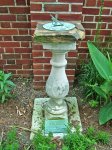 |
Philadelphia |
Pennsylvania |
USA |
Horizontal Dial |
Dial 148 |
| Horizontal dial approximately one foot diameter mounted on old stone atop a 3 foot stone pedestal. It is sitting against north wall of the garden and not aligned in proper direction. Plaque at the base states "This sundial stood for over a century in the gardens of Dorchester House, Park Lane, London, England. Presented by The Soroptomist Club of Philadelphia, December 23, 1935". This may be true for the dial plate because the hour angles indicate a latitude of 51°, the London latitude. It may not be true for the gnomon, whose style angle is 40°, the Philadelphia latitude. Access by taking guided tour, $5; then ask for garden. |
| |
| |
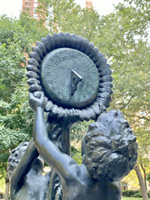 |
Philadelphia |
Pennsylvania |
USA |
Vertical Dial |
Dial 147 |
| Evelyn Taylor Price Memorial Sundial A vertical dial within a bronze sunflower held overhead in the outstretched arms of the bronze sculpture of two children. Dial is a vertical south decliner with hour marks from 6am to 6pm in Roman numerals. |
| |
| |
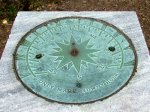 |
Philadelphia |
Pennsylvania |
USA |
Horizontal Dial |
Dial 146 |
| A 10 inch diameter horizontal dial on a 40 inch tall square marble pedestal with dedication plaque. Gnomon is missing. |
| |
| |
|
Sparkill |
New York |
USA |
Vertical Dial |
Dial 145 |
| 11' H x 7' W x 2' D. Mosaic tile and bronze Entitled 'Thorpe Village Sundial' |
| |
| |
|
Brooklyn |
New York |
USA |
Vertical Dial |
Dial 144 |
| 10' H x 7' W x 2' D Wood and stainless steel Entitled 'Sundial and Arches' |
| |
| |
|
Carona Queens |
New York |
USA |
Equatorial Dial |
Dial 143 |
| 11' H x 18' W x 11' D Bronze on Granite base Entitled 'Crack of Dawn Sundial.' Equatorial type, using a slot of sunlight as the gnomon |
| |
| |
|
Port Richmond, Staten Island |
New York |
USA |
Vertical Dial |
Dial 142 |
| 17' H x 11' W x 8' D Painted steel with stainless steel wire cloth Noon mark and analemma features made of concrete and brass. |
| |
| |
 |
Cove |
Oregon |
USA |
Equatorial Dial |
Dial 141 |
| An unusual sun sculpture 5 foot tall and approximately 20 inches in width and depth. Has hour and minute markings arranged on horizontal members. A 1/4 inch steel rod functions as the gnomon. The dial is set to read Pacific Daylight Solar Time, with a stated accuracy of 15 seconds of time. |
| |
| |
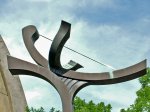 |
New York |
New York |
USA |
Equatorial Dial |
Dial 140 |
| A 20' H x 10' W x 5' D Equatorial in Bronze and Stainless Steel. Entitled "Song to the Sun." Dial by Robert Adzema; gift of George and Annette Murphy in 1984. |
| |
| |
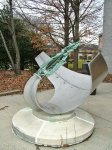 |
Franklin Center |
Pennsylvania |
USA |
Equatorial Dial |
Dial 139 |
| A modernistic equatorial dial about 6 feet in diameter. The analemma shaped gnomon casts standard time onto a wide metal semicircle band. The hours with 10-minute marks are inscribed on the center of the equatorial band. This unique sundial tells the time, indicates the approximate day of the month and projects the zodiacal constellation signs as they are aligned with the sun and the earth in this era. It is accurate to within two minutes. |
| |
| |
|
Shreveport |
Louisiana |
USA |
Horizontal Dial |
Dial 138 |
| Stone Dial vandalized. Gnomon missing, apparently knocked off with some damage to horizontal dial plate. Dial bears Roman numerals, from IV to VIII. |
| |
| |
 |
Boulder |
Colorado |
USA |
Horizontal Dial |
Dial 137 |
| A horizontal dial using a 60 cm brass plate gnomon with a slit that projects a shaft of light onto the dial face inscribed with un-numbered hour lines. Dial sits atop a cubical marble base with a plaque bearing the inscription. |
| |
| |
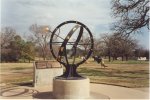 |
College Station |
Texas |
USA |
Armillary Sphere |
Dial 134 |
| Called the Texas A&M Armillary Sphere, this sundial is 60 inches in diameter. Made of wrought iron, it has one large vertical ring representing the meridian at College Station. Attached to the inside of this ring is a wide band representing the celestial equator. The outside of this band is decorated with gold signs of the zodiac. On the inside are gold Roman numerals for each hour. A rod with gold tip and ornate fan is the gnomon. A metal plaque mounted nearby gives a description of the dial and EoT corrections. Dial donated by Searcy Bracewell, class of '38. Built by Kenneth Lynch & Sons, Wilton, CT. Dial sits atop a concrete cylinder, 2 foot high, 3 foot diameter. |
| |
| |
|
McMinnville |
Oregon |
USA |
Vertical Dial |
Dial 133 |
| 8 x 6 ft Stainless steel and copper The hour lines project beyond the dial face, which is mounted about 12' out from the wall and cast digit-shaped shadows on it. Thus both the hour-lines and stile line are shadows. The dial is mounted on the south face of a tower, structurally an elevator shaft. The bronze plaque at the base contains the inscription. |
| |
| |
 |
St. Johns |
Newfoundland |
Canada |
Armillary Sphere |
Dial 132 |
| A 38.5 inch diameter bronze armillary with equatorial, meridian and horizon rings and with Roman hour numerals. Dial sits atop a six foot high concrete pedestal. The dial was restored in 1999 by Memorial University's Technical Services Department to celebrate the Festival of Anniversaries. |
| |
| |
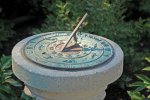 |
Salem |
Massachusetts |
USA |
Horizontal Dial |
Dial 131 |
| Approx. 10 inch diameter cast bronze horizontal dial. Inner ring has zodiac signs, middle ring has cherubs, leaves and a crown, and outer ring has hours 4AM-8PM in Roman numerals but no hour lines. The 6AM and 6PM lines are opposite each other but their hour lines do not pass through the root of the gnomon. It is believed the dial was installed about 1910 by then owner Caroline Emmerton. The dial was moved in 2007 to a less sunny location to make room for a seaman's memorial sculpture. The dial pedestal is traditionally decorated stone with circular top |
| |
| |
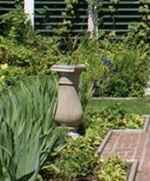 |
Portsmouth |
New Hampshire |
USA |
Horizontal Dial |
Dial 130 |
| Octagonal, approx 6 in. on a side Brass/Bronze Center compass rose, 4AM-8PM in Roman numerals. Standard stone pedestal. Probably not the original, as it is oversize for the dial plate. |
| |
| |
|
Toronto |
Ontario |
Canada |
Horizontal Dial |
Dial 128 |
| Approx 55 ft square Stone (concrete?) 4AM-8PM marked in Arabic numerals, half and quarter hours marked with lines. A huge dial. The gnomon is sunk below the outer level by a series of steps. The hours are marked by stone slab 'seats' spaced around the outer square. There are two seats at the noon position to allow for the width of the gnomon. This dial no longer exists. |
| |
| |
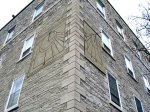 |
Ottawa |
Ontario |
Canada |
Vertical Dial |
Dial 127 |
| Two vertical declining dials declining 58.1° west and 31.9° east on adjacent sides of the south corner of the Sisters of Charity of Ottawa Mother House. The southwestern dial is approximately 7x8 feet (2.1m x 2.4m) and the southeastern dial is approximately 7x4 feet (2.1m x 1.2m) The dials are of gray plaster with black painted iron gnomons (the southwestern one being slightly bent). The southwestern dial has hour lines from 10 AM to 7 PM and the southeastern dial has hour lines from 7 AM to 3 PM. These dials predate the use of time zones and show local solar time. Mayall in his book on Sundials (p. 229) erroneously described this dial as on Mint Tower. Rather, Elisabeth Bruyere, Foundress of Sisters of Charity of Ottawa, wrote "In the course of the same winter, Fr. Allard had built a double sundial of great dimension on the southwest angle of the house (corner of Bolton and Sussex streets) which, even today, continues to give the correct time, as it did in Bruyere's time; she greatly appreciated the convenience. The work presupposed an advanced knowledge of mathematics and astronomy. It was the first of its kind in Canada." |
| |
| |
|
Cambridge |
Massachusetts |
USA |
Collection |
Dial 125 |
| Harold C. Ernst Collection |
| |
| |
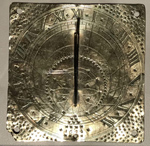 |
Salem |
Massachusetts |
USA |
Horizontal Dial |
Dial 124 |
| Here is a bronze dial approximate 8 inches in diameter with the date 1644. In spite of its age, it is now highly polished showing little if any wear to lines, engraving, and mounting holes. Roman hour numbers go from 5am to 7pm and the chapter ring is divided into quarter hours. The dial face is square and outside the hour ring are many small 5-point stars, stamped with a tool. The dial looks different from those made in London and the Proctor family immigrated to the New World in1635. Measuring the hour lines, the dial was probably made for Salem at 42.5 deg latitude. However an analysis of the hour lines shows the best fit latitude is 44.5 deg. The dial was presented to the Peabody Museum in 1907 by Abel Proctor and is attributed to John Proctor, who along with his wife Elizabeth, were accused of witchcraft in 1692. At the time Proctor was a wealthy tavern owner, but nevertheless was hanged. His wife was spared due to the fact she was pregnant, but remained "convicted" through out her life. |
| |
| |
|
Accokeek |
Maryland |
USA |
Armillary Sphere |
Dial 118 |
| Copper armillary dial 18 inches diameter. Two main rings are square1/2 inch tubing. Other parts of armillary are made of flat copper, about 3/4 inch wide. Has Roman numerals. Probably built by Ferguson family and installed in the 1920's. The dial base is cast cement, partly fluted, about 3-1/2 foot high, round at top, square at bottom. |
| |
| |
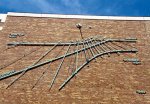 |
Seattle |
Washington |
USA |
Vertical Dial |
Dial 117 |
| Large vertical dial declining 36? west of south with hour lines, analemmal lines, sunrise and sunset limits, solstice lines. Metal structure mounted slightly away from brick building surface. Gnomon is a ball mounted on a rod emanating from sunburst. Visit the university of Washington web page to see this beautiful dial. |
| |
| |
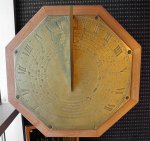 |
Williamsburg |
Virginia |
USA |
Horizontal Dial |
Dial 116 |
| A unique bronze 12-3/8 inch octagonal horizontal dial with one main hour ring for local time and six subsidiary rings that give the time in London, Vienna, Constantinople, Jerusalem, Barbados and Mexico City. The main hour ring shows hours in Roman numerals and ten minute intervals in Arabic numbers; each hour is divided into sixty minute intervals and "fleur-de-lis" decorations are placed at the thirty-minute marks. The subsidiary rings are inscribed with Roman numerals for daylight hours and Arabic numbers for night hours. The presence of subsidiary rings suggests the dial was made with an instructive or "world-view" intent. |
| |
| |
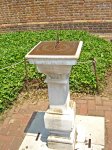 |
Williamsburg |
Virginia |
USA |
Horizontal Dial |
Dial 115 |
| A 14 inch square brass horizontal dial with hour lines and Roman numerals, compass rose and inscriptions honoring John Barrow. A fluted square pillar supports the dial. |
| |
| |
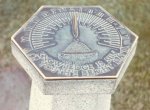 |
Salt Lake City |
Utah |
USA |
Horizontal Dial |
Dial 114 |
| Horizontal brass dial with a hexagonal shape, about 8 inches on a side. .Unusually small gnomon, only about 4 inches high. A beehive in relief is pictured at the base of the gnomon, perhaps explaining the hexagonal dial shape. Roman numerals with hour and quarter hour lines. Dial sits on a hexagonal pillar. |
| |
| |
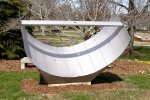 |
Collegedale |
Tennessee |
USA |
Cylindrical Dial |
Dial 113 |
| ca 6'cylindrical segment, about 3' high Stainless steel Large equatorial, corrected for longitude. Nodus is a hole on a horizontal gnomon rod running E/W across face. Can compensate for DST by shifting dial via bolts/slots in base. Solstice lines run along top/bottom edge of cylinder. Built by Fabricators Inc., Chattanooga TN |
| |
| |
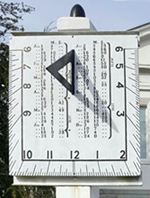 |
Barnwell |
South Carolina |
USA |
Vertical Dial |
Dial 112 |
| This vertical cast iron dial is a rectangle approximately 30x40 inches mounted on a pole. The Barnwell sundial was a gift to the city in Sept 1858 from state senator J.D. Allen, and has continuously shown civil time - accurate to within two minutes - for over 150 years. The vertical dial has an Equation of Time list of corrections for each week, giving the correction in minutes and seconds. A canon ball from the civil war sits atop the sundial. The dial is surrounded by a low circular wall with bronze statuary of a boy walking on the wall and a girl at some distance, looking at the dial. |
| |
| |
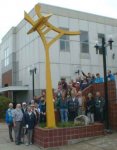 |
New Britain |
Connecticut |
USA |
Vertical Dial |
Dial 111 |
| A 19 ft steel sculpture named 'Sheng'. Commissioned by the Connecticut Commission on the Arts in 1987 and designed by Robert Adzema. Basically a combination East and West direct dial with a circular gnomon. |
| |
| |
 |
Bloomfield |
New Jersey |
USA |
Armillary Sphere |
Dial 109 |
| An armillary sphere 5 feet in diameter, with a bronze 8 inch equatorial band holding hour marks on the inside and decorated with animals of the zodiac on the outside. A simple rod serves as the gnomon. The armillary is supported by 8 cast bronze turtles on top of a four foot cylindrical pedestal. The turtles point to the cardinal and intermediary points of the compass. This very handsome dial was made by Kenneth Lynch. |
| |
| |
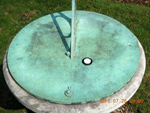 |
Pittsburgh |
Pennsylvania |
USA |
Horizontal Dial |
Dial 108 |
| A bronze and well patina circular horizontal dial about 18 inches in diameter. The dial is delineated in 10-minute increments with Arabic hour numbers. Dial sits atop a plain circular column. The gnomon is plain, secured to the dial plate with four bolts. |
| |
| |
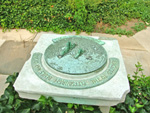 |
Pittsburgh |
Pennsylvania |
USA |
Horizontal Dial |
Dial 107 |
| In May of 1914, a beautiful sundial was erected in Schenley Park in memory of the Pittsburgh Blues, a company sent out from Pittsburgh. To remember this event Pennsylvania Chapters including the Keystone Chapter, Old Ironsides Chapter, General Robert Patterson Chapter, and the Stephen Decatur Chapter participated in the famous grave marking ceremonies which located, honored, and decorated hundreds of graves of men who served in the War of 1812 with custom made flags and flowers. |
| |
| |
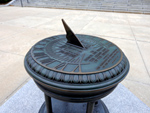 |
Des Moines |
Iowa |
USA |
Horizontal Dial |
Dial 106 |
| This beautiful horizontal brass dial is 24 inches in diameter, cast onto a larger circle 28 inches in diameter. The dial has raised hour, half-hour, and 15-minute lines drawn in esthetic proportions from 5 am to 7pm. Roman numerals are on the outer rim. In the center to the left and right of the gnomon is a table for the Equation of Time in 15 day increments. The dial rests on four brass columns 20 inches high, which are mounted on a brass base 28 inches in diameter. The entire structure is centered on a concrete octagon 6 1/2 feet across. |
| |
| |
|
Superior |
Arizona |
USA |
Horizontal Dial |
Dial 105 |
| A small 8 in. bronze horizontal dial with raised Arabic numerals marking the hours. The dial is set on a massive cobble stone and mortar base suitable for sitting upon while watching the hours. |
| |
| |
 |
Ambridge |
Pennsylvania |
USA |
Polyhedral Dial |
Dial 104 |
| In the garden of Old Economy Village is a 1964 reproduction of the historic 1825 original keep safety indoors. The 9-inch stone dial has four vertical dials on the E,W, N and S sides and one horizontal dial on top. The replica is in fair shape where the engraved hour lines are now severely weathered. The replica five iron gnomons are in fair condition, but still tell reasonably accurate local solar time. Each dial is delineated in half-hour marks with the hours shown in Arabic numbers. |
| |
| |
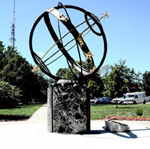 |
Oxford |
Ohio |
USA |
Armillary Sphere |
Dial 103 |
| A 6 foot armillary sphere sitting on a marble column supported by a ring of turtles. The armillary has equatorial, meridian, polar and equatorial rings, plus the arctic and antarctic rings near the poles. Along the outside of the equatorial ring are golden figures, marking the houses of the zodiac. On the inside of the equatorial ring are Roman numerals marking the hours. The armillary was a gift to the university on its 50th anniversary by the Miami chapter of Delta Delta Delta sorority. The plaque given coordinates of latitude and longitude of the dial that are slightly different than those from Google Earth, which are the coordinates given here. |
| |
| |
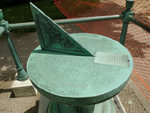 |
Dayton |
Ohio |
USA |
Horizontal Dial |
Dial 102 |
| A circular granite dial about 2 feet (.75cm) in diameter. It has an ornate, very large triangular gnomon of brass decorated with flowers. The dial sits on a sculpted column with spreading base. Protected by brass railing that surrounds the dial. The dial was erected in 1896 to celebrate Dayton's centennial. The dial was moved from its former location on Monument Avenue (originally called Main Street) in front of Newcom Tavern and relocated during ceremonies marking the moving of Newcom Tavern to Carillon Park on May 1, 1965. |
| |
| |
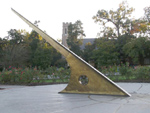 |
Chapel Hill |
North Carolina |
USA |
Horizontal Dial |
Dial 101 |
| A 35 foot diameter horizontal dial of terrazzo with inset bronze hour lines and Roman hour numerals. The bronze gnomon edge is 24 feet long and at the tip stands 14 feet tall. In the base of the gnomon is a circular opening, holding a large inset bronze hour glass. In the terrazzo at the dial center is an inset bronze sun graphic with wavy spicules; this inset contains a US Coast and Geodetic Survey Triangulation Station marker. A plaque gives correction for EOT and longitude. |
| |
| |
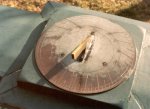 |
Long Island |
New York |
USA |
Horizontal Dial |
Dial 100 |
| A bronze circular horizontal dial about 18 inches in diameter. At the edge of the dial set in concentric rings are the hour lines, half hour lines, quarter hour and five minute marks. Hours are in Roman numerals from 5am to 7pm. Has a thick brass gnomon. |
| |
| |
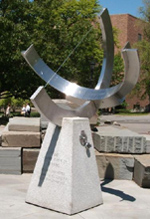 |
Ithaca |
New York |
USA |
Equatorial Dial |
Dial 99 |
| This 650 pound equatorial has a gear adjustment to rotate the equatorial time ring using a knob on the side of the pillar. This allows correction for the Equation of Time (sun's apparent variability in crossing the noon meridian and enables the instrument to read clock time, making this a very precise instrument. The gearing rusted in 1980 and was refurbished: "The heart of the sundial's functionality, a roundish steel disc called a cam, was also replaced with a stainless steel, slightly better-functioning one, connected to an hour and minute scale by small, stainless steel cables via a pair of precisely designed pulleys." Thus the mechanical adjustment compensates for the sun's irregular motion called the Equation of Time and shows civil not solar time. |
| |
| |
|
Morristown |
New Jersey |
USA |
Horizontal Dial |
Dial 98 |
| 12.75' dia. Granite with Bronze numerals 10" long. Commonly called the Washington Memorial Dial. An inscription on the octagonal base indicates this memorial is a tribute from the Daughters of the American Revolution. |
| |